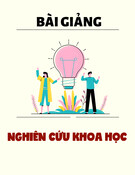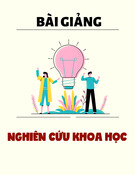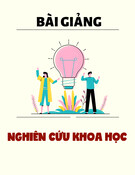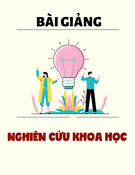
TNU Journal of Science and Technology
229(03): 185 - 192
http://jst.tnu.edu.vn 185 Email: jst@tnu.edu.vn
INTERCULTURAL TRAINING AND EFL STUDENTS’ INTERCULTURAL
COMMUNICATIVE COMPETENCE IN A HIGHER EDUCATION CONTEXT
OF VIETNAM
Nguyen Thi Bich Ngoc1*, Doan Thi Minh Tam1, Tran Minh Thanh2
1TNU - School of Foreign Languages
2TNU - University of Information and Communication Technology
ARTICLE INFO
ABSTRACT
Received:
30/12/2023
This paper discusses the effects of an intercultural communication
course on the development of students‟ intercultural communicative
competence, a crucial competence for language learners in the
globalised world. Using a mixed method approach that combines
survey reports with students‟ interviews, the study explored whether
there were any changes in students‟ intercultural knowledge, skills,
and attitudes before and after the course and to what extent the course
contributed to the development. A total of 122 English-majored
students took part in an online survey and 10 of them voluntarily
entered into semi-structured interviews. An adopted questionnaire
from Huang (2021) was used as the primary data collection
instrument. The findings indicated that while the course helped to
improve all components of intercultural communicative competence,
it supported more strongly the development of knowledge rather than
the other aspects, especially the skills component. Several suggestions
were given for the revision of course content and curriculum design.
Revised:
02/02/2024
Published:
02/02/2024
KEYWORDS
Intercultural competence
Intercultural training
Culture courses
Culture-language integrated
English language teaching
GIẢNG DẠY LIÊN VĂN HÓA VÀ NĂNG LỰC GIAO TIẾP LIÊN VĂN HÓA
CỦA SINH VIÊN TRONG BỐI CẢNH MỘT TRƯỜNG ĐẠI HỌC Ở VIỆT NAM
Nguyễn Thị Bích Ngọc1*, Đoàn Thị Minh Tâm1, Trần Minh Thành2
1Trường Ngoại ngữ - ĐH Thái Nguyên
2Trường Đại học Công nghệ Thông tin và Truyền thông – ĐH Thái Nguyên
THÔNG TIN BÀI BÁO
TÓM TẮT
Ngày nhận bài:
30/12/2023
Nghiên cứu này tìm hiểu tác động của khóa học giao tiếp liên văn hóa
đối với sự phát triển năng lực giao tiếp liên văn hóa của sinh viên, một
năng lực quan trọng với người học ngôn ngữ trong thế giới toàn cầu
hóa. Sử dụng phương pháp nghiên cứu hỗn hợp kết hợp khảo sát với
phỏng vấn sinh viên, nghiên cứu này tìm hiểu sự thay đổi về kiến
thức, kỹ năng và thái độ liên văn hóa của sinh viên trước và sau khóa
học và mức độ đóng góp của khóa học vào sự phát triển năng lực giao
tiếp liên văn hóa của sinh viên. 122 sinh viên chuyên ngành tiếng Anh
đã tham gia cuộc khảo sát trực tuyến và 10 sinh viên tình nguyện tham
gia các cuộc phỏng vấn bán cấu trúc. Bộ câu hỏi điều tra của tác giá
Huang (2021) được sử dụng làm công cụ chính để thu thập dữ liệu.
Kết quả chỉ ra rằng mặc dù khóa học giúp cải thiện tất cả các thành
phần của năng lực giao tiếp liên văn hóa nhưng có hiệu quả rõ nét
nhất về mặt kiến thức so với các thành tố khác, và kỹ năng là thành
phần ít được cải thiện nhất. Nghiên cứu đưa ra một số đề xuất cho
việc sửa đổi nội dung khóa học và thiết kế chương trình giảng dạy.
Ngày hoàn thiện:
02/02/2024
Ngày đăng:
02/02/2024
TỪ KHÓA
Năng lực liên văn hóa
Giảng dạy liên văn hóa
Khóa học về văn hóa
Dạy tích hợp văn hóa - ngôn ngữ
Giảng dạy tiếng Anh
DOI: https://doi.org/10.34238/tnu-jst.9514
* Corresponding author. Email: nguyenbichngoc.sfl@tnu.edu.vn

TNU Journal of Science and Technology
229(03): 185 - 192
http://jst.tnu.edu.vn 186 Email: jst@tnu.edu.vn
1. Introduction
The “cultural turn” has affected foreign language (FL) education profoundly in such areas as
reshaping the objectives of learning and teaching, revisiting the curriculum, and retraining the
teachers [1]. Intercultural communicative competence (ICC), the ability to communicate
effectively and appropriately with people from other languages and cultural backgrounds [2], has
become the main objective of FL teaching and learning [3]. Academic literature has proposed the
integration of culture in English language classrooms, with a focus on ICC as a key goal [4].
1.1. The Concept of ICC
Numerous definitions of intercultural competence (IC) have been put forth in the literature,
depending on scholars‟ disciplinary orientations, ideologies, and personal experiences. Some of
these include intercultural effectiveness, transcultural competence, intercultural communication
competence, cross-cultural awareness, intercultural communicative competence, intercultural
competence, intercultural sensitivity, and several others [5]. Within the discipline of foreign
language (FL) learning, intercultural communicative competence (ICC) is frequently utilized
interchangeably with IC; the concept of ICC was introduced by Byram in 1997 as a capability to
cultivate significant intercultural interactions using a foreign language [6].
This study employed Byram‟s (1997) concept and model of ICC [6] for it has been well-
established in the literature of intercultural studies and for its relevance to the context of language
learning and teaching in general and of this study‟s context in particular. The model proposes a
framework consisting of five distinct components, referred to as “saviors”. This term, derived
from the French language, is utilized to encapsulate the essential elements of ICC. These
components include knowledge (savoirs), intercultural attitudes (savoir être),
interpreting/relating skills (savoir comprendre), discovery/interaction skills (savoir apprendre/
faire), and critical cultural awareness (savoir s'engager).
1.2. Students’ ICC and Intercultural Training
In the global world, the practical implementation of the intercultural aspect in FL education
has continued to pose challenges. The removal of culturally specific content from educational
resources was a common practice, as publishers found it more convenient to market materials
devoid of cultural references to cater to a wider international audience [7]. Additionally,
integrated curriculum is still rare [1], and teachers lack experience and proper training in
incorporating the intercultural approach into their teaching practice [8].
Most studies about students‟ ICC have focused on investigating the effects of training
interventions on students‟ perceived ICC. The findings suggest that intercultural training and
cultural immersion positively impact students‟ perceived ICC, leading to an improvement in their
ICC [9]. Studies also confirmed the effectiveness of studying abroad and telecollaboration [10],
[11]. For example, Young and Schartner [12] investigated the effects of a curriculum centered on
cross-cultural communication (CCC) on the ability of international students to adapt and adjust.
They found that individuals pursuing a degree in CCC exhibited superior performance of
academic success than those with a similar curriculum deemphasizing CCC.
In Vietnam, it was not until after 2008, with the mark of the National Foreign Language
Project (NFLF), that IC gained its attention in EFL [13]. Since then, EFL policies in Vietnam
have supported the development of ICC among learners (e.g., The National Foreign Language
Project, the Higher Education Qualification Framework, and the National School Curriculum).
Although the macro policies support intercultural language teaching and the importance of
culture teaching has been stated in foreign language classrooms, studies have suggested that the
actual practice of intercultural language teaching in Vietnam is still under a lot of struggle [14].
With regards to ICC in teachers‟ perceptions and their pedagogical practice, Vietnamese
English as a foreign language (EFL) instruction tends to focus on providing students with

TNU Journal of Science and Technology
229(03): 185 - 192
http://jst.tnu.edu.vn 187 Email: jst@tnu.edu.vn
linguistic knowledge, while cultural knowledge integration is limited [15], [16]. Although
teachers are aware of the significance of culture in foreign language education, culture has not
received much attention in English classrooms [17]. In addition, most studies on ICC in Vietnam
tend to focus on teachers‟ perceptions and practices or the representation of culture in English
textbooks; few have investigated students‟ ICC and their perceptions of ICC training at the
university level [18], [19].
Responding to the changes in macro policies and recognising the importance of ICC in higher
education, the university, which is the context of this study, has included explicit intercultural
training in its curriculum since 2018. The university has included an intercultural training course
(the Intercultural Communication course) which aims to develop students‟ ICC. The course
content was based on course designers‟ perspectives guided by Byram‟s [6] and Deardorff‟s [20]
theory of ICC. The course covers 15 weeks, with a 3-hour class per week, and is delivered as a
compulsory course for third-year students. The pedagogical approach combines lectures with
students‟ presentations, written reflections, and group projects on explaining cultural differences,
reflecting on one‟s beliefs and values, or explaining cultural problems and suggesting solutions.
Although the course has been implemented for several years, to date, there have not been any
attempts to investigate the effectiveness of the course in developing learners‟ ICC, especially from
the viewpoints of the students, a crucial stakeholder in any educational process.
This paper discusses the results extracted from a larger study that examines the impact of an
intercultural communication course (now called IC course) on students‟ perceived intercultural
communicative competence. This study hopes to fill the existing literature gap and tackle the
local context‟s inherent challenges.
2. Methods
The study seeks the answers to the following questions: (1) What are the students‟ perceived ICC
levels before and after their participation in the IC course? (2) To what extent does the IC course
affect students‟ ICC? To address the questions, both quantitative and qualitative data were ultilized
following the sequential explanatory design [21]. The pre- and post-ICC questionnaires were
delivered to 122 English major students, and the follow-up interviews were done with ten students.
The survey items were adapted from Huang‟s [22], which was used to gauge students‟
perceived levels of ICC before and after the training. In his original survey, Huang [22] rearranged
the ICC components and blended the awareness component into the knowledge one. The survey in
this study followed the same arrangement with 25 statements on a Likert scale of 1-5. The 25
statements were divided according to the three-dimensional model: knowledge (9 statements), skills
(9 statements), and attitudes (7 statements). Mean scores and standard deviations were utilized in
descriptive statistics. Afterward, paired-sample T-tests were used to analyze the relationships
between the pretest and post-test scores. The measurement was interpreted as very low (1.0-1.5),
low (1.51-2.50), moderate (2.51-3.50), high (3.51-4.50), and extremely high (4.51-5.0) basing on
Paige et al.‟s guidelines [23]. In the qualitative phase, student interviews were designed based on
the qualitative findings, aiming to explain the results of the previous phase. Students were asked to
justify the reasons for the differences in their perceived levels of different ICC components reported
in the questionnaire, their perceptions of the contribution of course to their ICC as well as their
wishes and suggestions for future training related to ICC.
3. Results and Discussion
3.1. Students’ ICC before and after the IC course
Students’ ICC before the course
Concerning the knowledge component (Table 1), students expressed their high ICC
knowledge (M = 3.60). Especially, students have a high score on knowledge about their own
culture (item 6: M = 3.84, SD = 0.85) and the recognition of differences in cultures (item 8, M =

TNU Journal of Science and Technology
229(03): 185 - 192
http://jst.tnu.edu.vn 188 Email: jst@tnu.edu.vn
3.84, SD = 0.80; item 7, M = 3.75; S.D = 0.75). However, they demonstrated moderate
knowledge of other cultures (item 5, M = 3.0, SD = 0.73). The results indicated that students
already possess a good understanding of their own culture, and they know, to a certain extent,
other cultures in the world.
In terms of the skills component, students expressed their moderate ICC skills (M = 3.20). The
lowest scores fell into item 12 (communicating with people from other cultures easily; M = 2.83)
and item 13 (interpreting cultural practices, beliefs, or values of other cultures; M = 2.73). The
highest score went for the skill of telling people about your own country and culture (item 18, M
= 3.66, SD = 0.83). These results are also in line with those regarding students‟ knowledge in
which students were more confident with issues related to their own culture.
Table 1. Students’ ICC knowledge before doing the IC course
ICC knowledge
N
Min
Max
M
S.D
5. I know about other cultures in the world.
122
2
5
3.00
0.73
6. I am aware that my culture influences the way I interpret the behaviors
of people from other cultures.
122
2
5
3.84
0.85
7. I know that although someone may look different from me, we may
share a lot in common.
122
2
5
3.75
0.75
8. I know there are cultural differences in nonverbal communication.
122
3
5
3.84
0.80
Overall knowledge
122
2.78
4.78
3.60
0.44
ICC skills
N
Min
Max
M
S.D
12. I can communicate with people from other cultures easily.
122
1
5
2.83
0.80
13. I can interpret cultural practices, beliefs or values of other cultures.
122
1
4
2.73
0.80
18. I am confident in telling people about my own country and culture.
122
2
5
3.66
0.83
Overall skills
122
2.11
4.11
3.20
0.47
ICC attitudes
N
Min
Max
M
S.D
20. I am interested in learning about and understanding other cultures.
122
2
5
3.36
0.80
22. I respect the values of people from other cultures.
122
2
5
4.02
0.86
23. When I meet someone from another country, I show an interest in
understanding his/her culture.
122
2
5
3.32
0.81
24. When people from other cultures behave differently, I can respect the
differences.
122
2
5
3.93
0.83
Overall attitudes
122
2.14
4.86
3.62
0.63
With respect to the attitudes component, students demonstrated high ICC attitudes (M = 3.62).
Noticeably, students expressed their high attitude toward respecting the values of people from
other cultures (item 22, M = 4.02, SD = 0.86) and respecting the differences when people from
other cultures behave differently (item 24, M = 3.93, SD = 0.83). However, the attitude of being
interested in learning about and understanding other cultures (items 20 and 23) received the
lowest mean scores of 3.36 and 3.32, respectively.
In short, descriptive findings indicated that students had moderate to high levels of ICC
components before the course. Of these, the most significant was students‟ ICC attitudes (M =
3.62), followed by their ICC knowledge (M = 3.60) and skills (M = 3.2). Students demonstrated
high perceived levels of knowledge about and performance in issues related to their own culture;
however, they were not as confident in their knowledge about other cultures and their skills to
perform smoothly with cultural otherness. While they showed high levels of respect for cultural
differences, they did not demonstrate a strong desire to learn more about their culture and other
cultures. These findings could provide useful reasons for training, particularly in areas of
equipping students with more cultural knowledge, skills, and attitudes regarding other cultures.
Students’ ICC after the course
As depicted in Table 2, students illustrated their high ICC knowledge (M = 4.16). Like the
pretest, students expressed their highest level of understanding of their own culture (item 1, M =
4.34, SD = 0.65) and the lowest level of knowledge about other cultures in the world (item 5, M

TNU Journal of Science and Technology
229(03): 185 - 192
http://jst.tnu.edu.vn 189 Email: jst@tnu.edu.vn
= 3.61, SD = 0.77). In addition, students also expressed their high awareness of the differences in
nonverbal communication (M = 4.40, SD = 0.63) and the challenges and benefits of cultural
diversity (M = 4.32, SD = 0.67).
Table 2. Students’ ICC after the course
ICC knowledge
N
Min
Max
M
S.D
1. I know about my own culture.
122
3
5
4.34
0.65
4. I am aware of the challenges and benefits of cultural diversity.
122
3
5
4.32
0.67
5. I know about other cultures in the world.
122
2
5
3.61
.077
8. I know there are cultural differences in nonverbal communication.
122
3
5
4.40
0.63
Overall knowledge
122
3.00
5.00
4.16
0.49
ICC skills
N
Min
Max
M
S.D
11. I can recognize cultural rules and biases different from those of my own.
122
2
5
3.97
0.76
12. I can communicate with people from other cultures easily.
122
2
5
3.43
0.84
17. I am confident in my abilities to adapt to a new country or culture.
122
1
5
3.49
0.87
18. I am confident in telling people about my own country and culture.
122
3
5
4.20
0.69
Overall skills
122
2.78
5.00
3.67
0.56
ICC attitudes
N
Min
Max
M
S.D
19. I like spending time exploring my own culture.
122
2
5
4.14
0.71
20. I am interested in learning about and understanding other cultures.
122
3
5
3.88
0.64
21. I enjoy interacting with people from other cultures
122
2
5
3.87
0.86
22. I respect the values of people from other cultures.
122
3
5
4.40
0.60
23. When I meet someone from another country, I show an interest in
understanding his/her culture.
122
2
5
3.91
0.74
24. When people from other cultures behave differently, I can respect the
differences.
122
3
5
4.36
0.63
25. I don‟t immediately draw negative conclusions when people from other
cultures do or see things differently.
122
1
5
4.12
0.85
Overall attitudes
122
3.00
5.00
4.10
0.49
For ICC skills, students also expressed their high ICC skills (M = 3.67). Compared to the
knowledge component, the overall score for the skills component was lower. The highest scores
were for item 18 (telling people about my own country and culture) and item 11 (recognizing
cultural rules and biases different from those of my own), with a mean score of 4.20 and 3.97,
respectively. On the other hand, the lowest scores were seen in items 12 (communicating with
people from other cultures easily) and 17 (adapting to a new country or culture). Compared to
the pretest result, students seemed better at recognising cultural rules and biases.
In terms of the attitudinal component, students depicted their high ICC attitudes (M = 4.10).
Specifically, participants highly agreed with three items: item 19 (I like spending time exploring
my own culture; M = 4.14, SD = 0.71), item 22 (respect the values of people from other cultures;
M = 4.40, SD = 0.60), item 24 (respect the differences in behaviors of cultural others; M = 4.36,
SD = 0.63).
In summary, after the IC course, students‟ ICC levels were marked “high” in all three
components, of which the knowledge component showed the highest scores (M = 4.16), followed
by attitudes (M = 4.10) and skills (M = 3.67).
3.2. The effect of the IC course on students’ ICC
Results from the questionnaire
A paired-sample t-test was conducted to evaluate the impact of the IC course on students‟ ICC
on three components; the most significant results are shown in Table 3.
As can be seen from table 3, concerning the ICC knowledge, overall results indicated that
there was a statistically significant increase in students‟ ICC knowledge from phase 1 (before
doing the IC course) (M = 3.58, SD = 0.40) to phase 2 (after doing the IC course) (M = 4.16, SD
= 0.44), t (121) = -10.58, p < 0.000 (two-tailed). The mean increase in IC knowledge was 0.58,

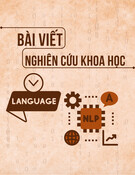
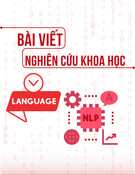


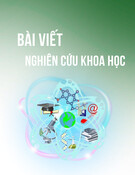




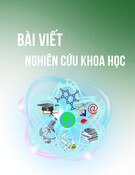



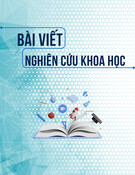

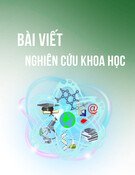

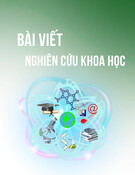


![Định hướng giáo dục STEM trong trường trung học: Tài liệu [chuẩn/mới nhất]](https://cdn.tailieu.vn/images/document/thumbnail/2025/20251124/dbui65015@gmail.com/135x160/25561764038505.jpg)
